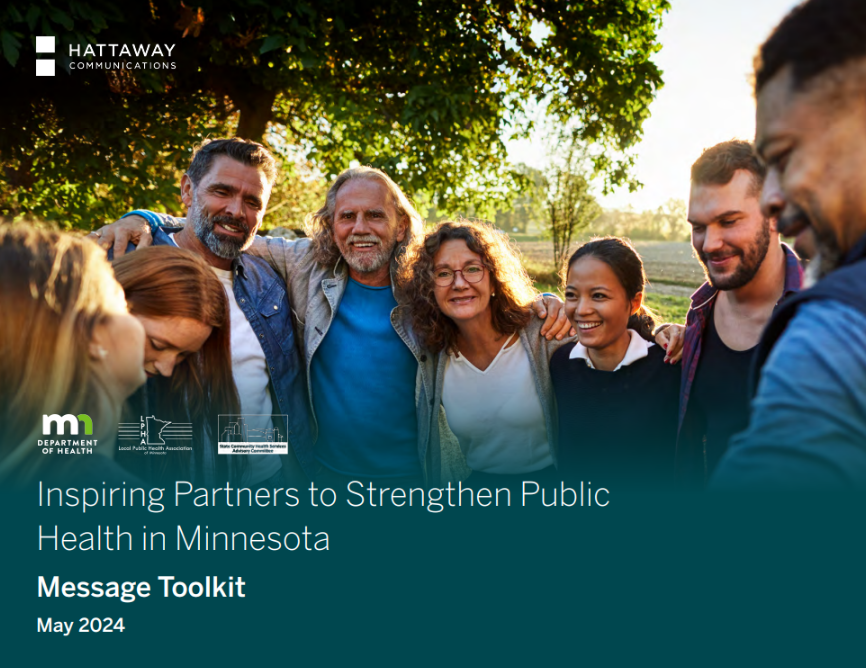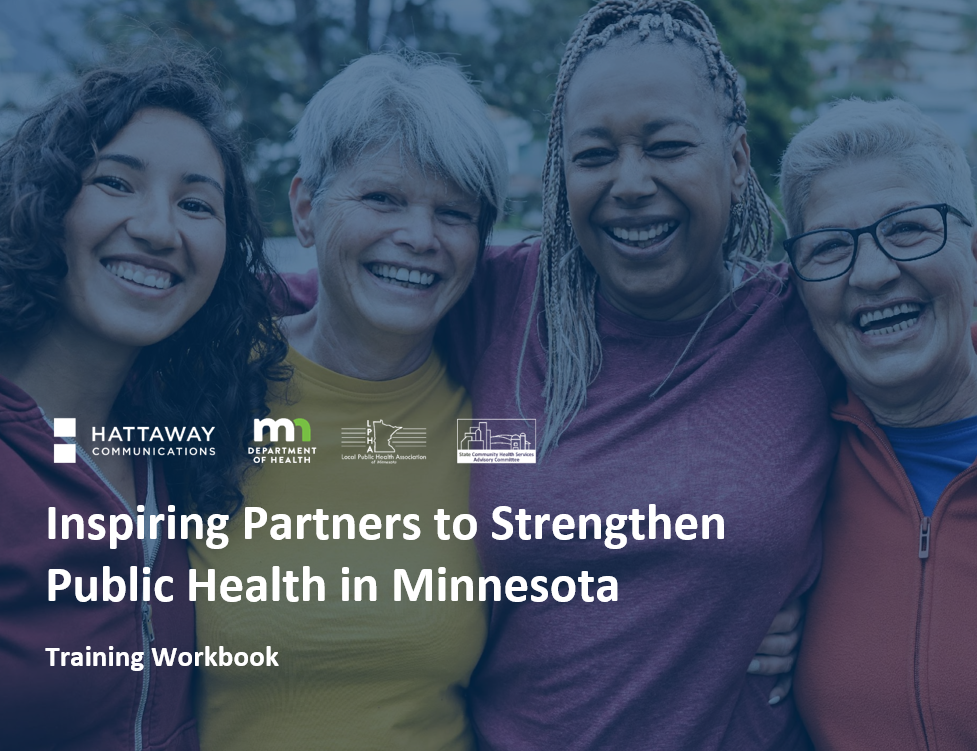Transforming Minnesota's Public Health System
- Home: System Transformation
- About This Work
- Framework of Foundational Responsibilities
- Definitions, Criteria, and Standards for Fulfillment
- Joint Leadership Team
- Minn. Infrastructure Fund and Local Innovation Projects
- Governance Groups and Communities of Practice
- Data Modernization
- Regional Data Models
- Tribal Public Health Capacity and Infrastructure
- FPHR Grant: Funding for Foundational Responsibilities
- Reports, Fact Sheets, Resources
- Newsletter
- Message Toolkit
Related Sites

Message Toolkit: Inspiring Partners to Strengthen Public Health in Minnesota
Transforming the Public Health System in Minnesota
This toolkit can help anyone communicate effectively and efficiently about the role and value of public health: what public health is, what public health does, and why we need a more seamless, responsive, and publicly-supported governmental public health system.
Download Quick Start Guide Full Toolkit Workbook
More on this page:
How to use this toolkit
Schedule a workshop for your staff
Download the toolkit and workbook
About this toolkit
How to use this toolkit
Download the toolkit: Message Toolkit: Inspiring Partners to Strengthen Public Health in Minnesota (PDF)
Follow steps 1-3 below to create a message driven by shared values and goals.
Steps 1-3 are also described on this quick start guide (PDF).
Use this workbook to help you brainstorm:
Print and write by hand: Message Workbook, printable version (PDF)
Download and edit in MS Word: Message Workbook, MS Word version (DOC)
1. When using this toolkit, start by imagining
- A single audience: A clear, specific person or group (not “the community” or “the public”)
- A clear action or objective: A specific thing you’d like them to do
- Trusted messengers: Who does your audience trust for knowledge and information?
2. Once you're in front of your audience, introduce your issue or work with a message that includes all five parts of the message frame
- Value of public health: How does public health make a positive impact in your community, in a way that your audience understands? What’s in it for your audience if they support public health?
- People: Who are the community experts and leaders that need to work together? What values do they share or have in common? (Note: "People" may be the same group/sector as your audience, but may also be different.)
- Goal: Our goal is to help all Minnesotans live their healthiest lives. What does that look like in your community, in way(s) that might be specific to the group you’re talking to or particularly resonate with them?
- Problem: What barriers stand in the way to you achieving your goal? Consider things you can actually help address. Keep it simple. Remember, try not to start your message with the problem.
- Solution: What are you proposing to help your audience reach the goal? Show both individual and societal benefits. This solution should align closely with the action item you’re asking of your audience. It may not be an end result, but could be a process or method (like a new way of doing or funding something, for example).
3. After you introduce your issue or work, then tell stories that bring your message to life, and share data or proof points that support your message
- Stories/examples help your audience feel like they’re “in the river” too, creating a thriving community with you, and will often stick with audiences long after they forget data points.
“I could tell you about the river, or we could just get in.” – Bill Callahan, singer-songwriter - Data can help show the return on investment of public health work, or make public health's reach clear and show the value of cooperation.
Schedule a workshop for your staff
To discuss a workshop for your staff, please contact Murphy Anderson, communications coordinator, MDH Center for Public Health Practice.
At the present time, workshops are open to local public health staff, tribal health staff, MDH staff, and members of the State Community Health Services Advisory Committee (SCHSAC).
Download the toolkit and workbook
Toolkit: Message Toolkit: Inspiring Partners to Strengthen Public Health in Minnesota (PDF)
Workbook:
Print and write by hand: Message Workbook, printable version (PDF)
Download and edit in MS Word: Message Workbook, MS Word version (DOC)
About this toolkit
Hattaway Communications worked with Minnesota public health workers and allies to develop the guidance in this toolkit, using science-based models for persuading and motivating people through language that informs and inspires.
Hattaway led extensive engagement with MDH, LPHA, and SCHSAC, as well as local, state, and tribal public health experts, elected officials, and other community leaders, to ensure that the recommendations were based on a deep understanding of the needs of public health personnel and communities statewide.
- Who is this toolkit for? Anyone who works to create healthy communities can use the message frame in this toolkit to talk with state and local public health experts, elected officials, nonprofit leaders, and other important decision-makers who influence public health in Minnesota.
- What does this toolkit do? The message frame in this toolkit can help you make sure your talking points address the group you're talking with and their hopes and vision, to help them understand how you are part of each other's work to build healthy communities. You can use the frame for any issue, with any community, in every part of the state.
Related
- Narratives and Health Equity: Expanding the Conversation: Borrow text and ideas from narratives about how health is impacted by housing, income, incarceration, racism, and more.
- Communications Community of Practice: The Communications Community of Practice (CoP) brings together local public health staff doing communications work, every other month, online. Participants are not necessarily full-time communications staff.

